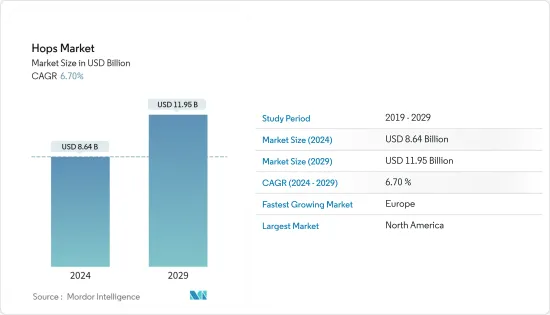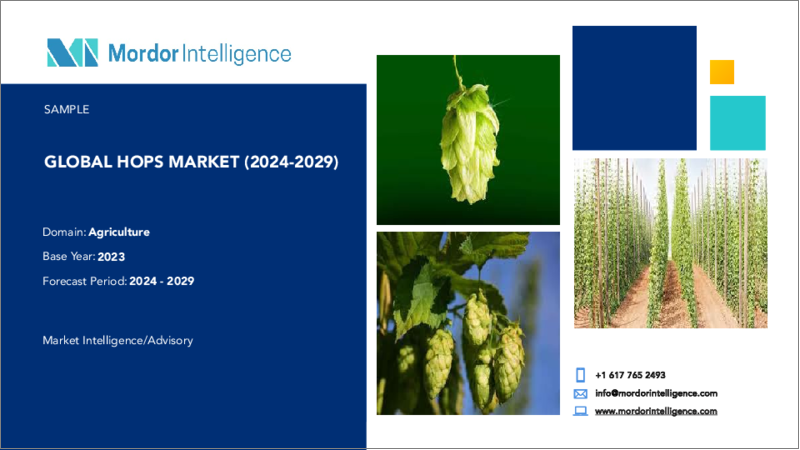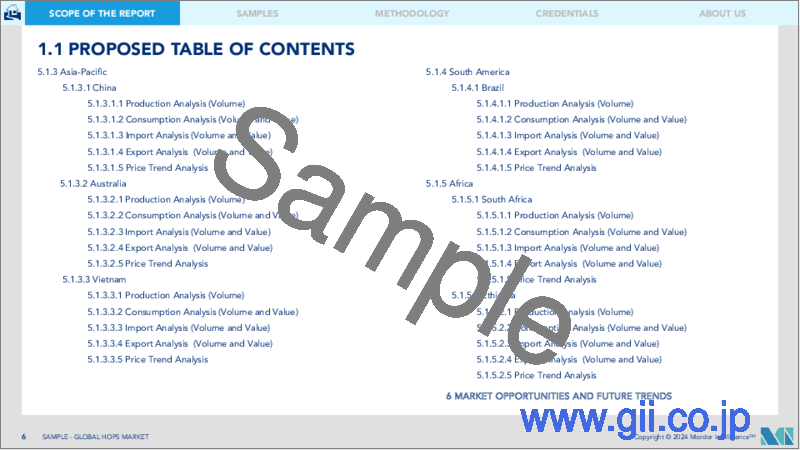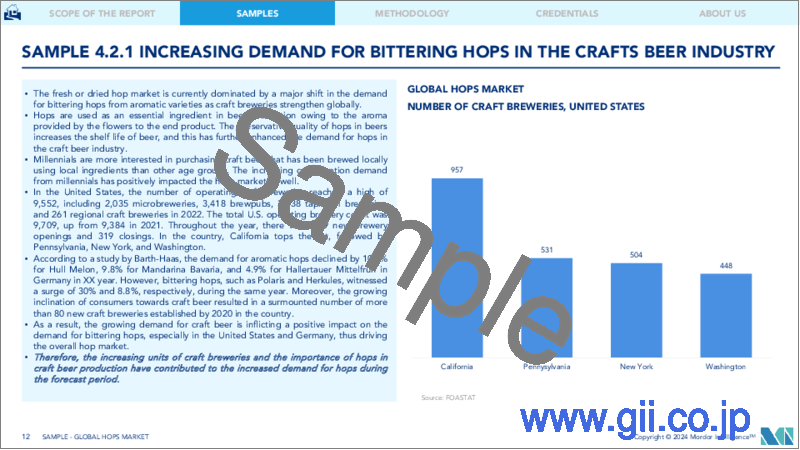|
|
市場調査レポート
商品コード
1445618
ホップ:市場シェア分析、業界動向と統計、成長予測(2024~2029年)Hops - Market Share Analysis, Industry Trends & Statistics, Growth Forecasts (2024 - 2029) |
||||||
カスタマイズ可能
適宜更新あり
|
|||||||
| ホップ:市場シェア分析、業界動向と統計、成長予測(2024~2029年) |
|
出版日: 2024年02月15日
発行: Mordor Intelligence
ページ情報: 英文 95 Pages
納期: 2~3営業日
|
全表示
- 概要
- 目次
概要
ホップ市場規模は2024年に86億4,000万米ドルと推定され、2029年までに119億5,000万米ドルに達すると予測されており、予測期間(2024年から2029年)中に6.70%のCAGRで成長します。

主なハイライト
- ホップ植物はカンナ科の植物で、主にビールの苦味、風味付け、安定剤として使用されます。ホップは、他の飲料や薬草のさまざまな目的にも使用されます。アロマ品種からのビタリングホップの需要の過渡的な変化と、世界中のクラフトビール醸造所の成長の前向きな軌道が、世界のホップ市場を牽引しています。
- 米国農務省(USDA)によると、米国は引き続き96%の市場シェアを誇る主要な供給国です。香港はホップ輸入量の72%を地域内の他の市場に再輸出し、28%は地元のビール醸造所向けに保持しました。COVID-19感染症のパンデミックにもかかわらず、国内ビールの売上高は安定しており、2022年には8億6,700万米ドルに達し、2026年までに11億米ドルに成長すると予想されています。ビール売上の着実な成長により、より多くの地元のビール醸造所が生産を拡大し、需要が増加すると考えられます。米国品質のホップを使用。これにより、今後数年間のホップ市場の成長が促進されるでしょう。
- 2021年に最も急成長した市場は欧州であり、英国とフランスが地域市場をリードしました。 2021年に英国が1,279トンのホップコーンを輸入し、フランスがそれに続き、同年の総輸入量は684トンとなった。輸入ホップとは別に、欧州ではドイツでもホップ栽培が着実に復活しており、2020年の生産量は870万トンで、前年に比べて増加しました。これらの要因がこの地域の今後数年間の成長を後押しします。
ホップ市場動向
クラフトビールにより苦みのあるホップの需要が高まっている
- クラフトビール醸造所が世界的に拡大するにつれて、ビターリングホップの需要は芳香品種から大幅にシフトし、生ホップや乾燥ホップ市場を独占しています。 Worldwide Brewing Allianceの調査によると、ビールは世界で最も消費されているアルコール飲料であり、水とお茶に次いで3番目に多く消費されています。世界のホップ市場は、予測期間中に大幅に上昇すると予想されます。
- 2021年の市場は安定した速度で成長しており、主要企業による戦略の採用の増加により、市場は予測期間を超えて上昇すると予想されます。米国では、小売クラフトビール市場は2021年に268億米ドルと評価され、販売量で8%の成長を記録し、量で米国のビール市場全体の13.1%を占めました。同時に、ビール醸造者協会によると、米国のクラフトビール醸造所の数は2021年に9,118軒に増加し、2020年の8,905軒から4.4%増加しました。
- さらに、Barth-Haasの調査によると、国内のパンデミックの影響で、前年の2019年と比較すると、アロマティックホップの需要と生産量はわずかに減少しました(Perleが5,481トン、Mandarina Bavariaが673トン、 Hallertauer Mittelfruhが757トン)しかし、2020年には同じ年に、PolarisやHerkulesなどのビタリングホップの生産量がそれぞれ増加しました。
- クラフトビールに対する消費者の傾向の高まりにより、2020年には米国で213の新しいクラフトビール醸造所が設立されました。その結果、クラフトビールの需要の高まりが、特に米国とドイツでのビタリングホップの需要に好影響を与え、ホップ市場全体を牽引しています。
欧州は最も急速に成長する市場
- 欧州は2022年にホップの最も急成長する市場となったが、これは輸入量の増加と、増え続けるビール需要によるホップ栽培面積の拡大の両方によって決定されます。ドイツは米国に次ぐ世界第2位のホップ生産国です。しかし、夏の熱波と干ばつは、特に2022年の早生品種の生産に深刻な影響を及ぼしました。
- ロシアとウクライナの戦争により、地元のビール醸造業者はホップや設備の供給に混乱をきたし、ビールの品揃えを維持するために国内の代替品を探すことを余儀なくされました。ビール醸造会社3社が協力して、ロシアのビール醸造業者による米国と欧州のホップへのアクセスを阻止したことで、外国のライバル企業が市場から撤退する一方で、ロシア企業がホップ市場で拡大できるようになった。
- 輸入市場は英国、フランス、スペイン、ドイツが独占しており、2021年にはそれぞれ合計1,279トン、684トン、631トンのホップを輸入しています。さらに、欧州は世界最大のビール消費地域であり、一人当たりのビート消費量はチェコ共和国が143.3リットルで最も多く、次いでドイツが104.2リットル、ポーランドが100.8リットル、アイルランドが続いています。一人当たり98.2リットルなど。
- 欧州連合では約2,600の農場がホップを栽培しており、その面積は26,500ヘクタール、全世界のホップ栽培に使用されている総表面積の60%を占めています。ホップは欧州連合(EU)の14か国で栽培されています。ドイツでは約17,000ヘクタールがホップ栽培に使用されており、これは欧州連合のホップ栽培面積の60%を占め、世界中でホップ栽培に充てられる表面積の約3分の1を占めます。他の主要なEU生産国は、チェコ、ポーランド、スロベニアです。その結果、この地域のホップの需要も大幅に増加し、予測期間中に堅調な成長が見られるとさらに予想されています。
ホップ業界の概要
その他の特典
- エクセル形式の市場予測(ME)シート
- 3か月のアナリストサポート
目次
第1章 イントロダクション
- 調査の前提条件と市場の定義
- 調査範囲
第2章 調査手法
第3章 エグゼクティブサマリー
第4章 市場力学
- 市場概要
- 市場促進要因
- 市場抑制要因
- バリューチェーン分析
第5章 市場セグメンテーション
- 地域
- 北米
- 米国
- 生産分析
- 消費分析と市場規模
- 輸入市場分析(量と金額)
- 輸出市場分析(量と金額)
- 価格動向分析
- カナダ
- 生産分析
- 消費分析と市場規模
- 輸入市場分析(量と金額)
- 輸出市場分析(量と金額)
- 価格動向分析
- 欧州
- ドイツ
- 生産分析
- 消費分析と市場規模
- 輸入市場分析(量と金額)
- 輸出市場分析(量と金額)
- 価格動向分析
- 英国
- 生産分析
- 消費分析と市場規模
- 輸入市場分析(量と金額)
- 輸出市場分析(量と金額)
- 価格動向分析
- ロシア
- 生産分析
- 消費分析と市場規模
- 輸入市場分析(量と金額)
- 輸出市場分析(量と金額)
- 価格動向分析
- チェコ共和国
- 生産分析
- 消費分析と市場規模
- 輸入市場分析(量と金額)
- 輸出市場分析(量と金額)
- 価格動向分析
- ベルギー
- 生産分析
- 消費分析と市場規模
- 輸入市場分析(量と金額)
- 輸出市場分析(量と金額)
- 価格動向分析
- ポーランド
- 生産分析
- 消費分析と市場規模
- 輸入市場分析(量と金額)
- 輸出市場分析(量と金額)
- 価格動向分析
- スロベニア
- 生産分析
- 消費分析と市場規模
- 輸入市場分析(量と金額)
- 輸出市場分析(量と金額)
- 価格動向分析
- アジア太平洋
- 中国
- 生産分析
- 消費分析と市場規模
- 輸入市場分析(量と金額)
- 輸出市場分析(量と金額)
- 価格動向分析
- オーストラリア
- 生産分析
- 消費分析と市場規模
- 輸入市場分析(量と金額)
- 輸出市場分析(量と金額)
- 価格動向分析
- ベトナム
- 生産分析
- 消費分析と市場規模
- 輸入市場分析(量と金額)
- 輸出市場分析(量と金額)
- 価格動向分析
- 南米
- ブラジル
- 生産分析
- 消費分析と市場規模
- 輸入市場分析(量と金額)
- 輸出市場分析(量と金額)
- 価格動向分析
- アフリカ
- 南アフリカ
- 生産分析
- 消費分析と市場規模
- 輸入市場分析(量と金額)
- 輸出市場分析(量と金額)
- 価格動向分析
- エチオピア
- 生産分析
- 消費分析と市場規模
- 輸入市場分析(量と金額)
- 輸出市場分析(量と金額)
- 価格動向分析
- 北米
第6章 市場機会と将来の動向
目次
Product Code: 70083
The Hops Market size is estimated at USD 8.64 billion in 2024, and is expected to reach USD 11.95 billion by 2029, growing at a CAGR of 6.70% during the forecast period (2024-2029).

Key Highlights
- The hop plant is a member of the cannabaeceae family, mainly used in bittering, flavoring, and as stability agents in beer. Hops are also used for several purposes in other beverages and medicinal herbs. A transitional shift in the demand for bittering hops from aroma varieties and a positive trajectory in the growth of craft breweries across the world are driving the global hops market.
- According to the United States Department of Agriculture (USDA), the United States continues to be the leading supplier with a 96% market share. Hong Kong re-exported 72% of its hop imports to other markets in the region, retaining 28% for local breweries. Despite the COVID-19 pandemic, domestic beer sales were stable, reaching USD 867 million in 2022, and will grow to USD 1.1 billion by 2026. The steady growth of beer sales is likely to encourage more local breweries to boost their production, increasing demand for US-quality hops. This will boost the growth of the hops market in the coming years.
- Europe was the fastest-growing market in 2021, with the United Kingdom and France leading the regional market. The United Kingdom imported 1,279 metric tons of hop cones in 2021, followed by France, with total imports of 684 metric tons during the same year. Apart from imported hops, Europe has also witnessed a steady revival in the cultivation of hops in Germany, where the production stood at 8.7 million metric tons in 2020, which has increased compared to the previous year. These factors are boosting the region to grow in the coming years.
Hops Market Trends
Craft Beer is Elevating the Demand for Bittering Hops
- As craft breweries expand globally, the demand for bittering hops has significantly shifted away from aromatic varietals, dominating the fresh or dried hop market. According to a study by the Worldwide Brewing Alliance, beer is the most consumed alcoholic drink globally and the third most consumed after water and tea. The global hops market is anticipated to rise considerably during the forecast period.
- In 2021, the market was growing at a steady rate, and with the rising adoption of strategies by key players, the market is expected to rise over the projected horizon. In the United States, the retail craft brewery market was valued at USD 26.8 billion in 2021, witnessing a growth of 8% in volume sales and accounting for 13.1% of the total beer market in the United States in terms of volume. Simultaneously, the number of craft breweries in the United States grew to 9,118 in 2021, a 4.4% increase over 8,905 in 2020, as per the Brewers Association.
- Moreover, according to a study by Barth-Haas, the demand for aromatic hops and production slightly decreased due to the pandemic in the country when compared to the previous year of 2019 (Perle with 5,481 metric tons, Mandarina Bavaria with 673 metric tons, and Hallertauer Mittelfruh with 757 metric tons). However, the production of bittering hops such as Polaris and Herkules increased in the year 2020, respectively, during the same year.
- The growing inclination of consumers toward craft beer resulted in the establishment of 213 new craft breweries in 2020 in the United States. As a result, the growing demand for craft beer is inflicting a positive impact on the demand for bittering hops, especially in the United States and Germany, thus, driving the overall hop market.
Europe - The Fastest Growing Market
- Europe was the fastest-growing market for hops in 2022, which is determined by both growing imports and an expansion in the area under hop cultivation, driven by an ever-growing demand for beer. Germany is the world's second-biggest producer of hops after the United States. However, the heatwaves and drought of the summer severely affected production, particularly of early-maturing varieties in 2022.
- The Russia-Ukraine war disrupted local beer brewers' hops and equipment supplies, forcing them to seek domestic alternatives as they strived to keep their range of beers flowing. Three brewing companies collaborated to block Russian brewers' access to US and European hops, which allowed Russian businesses to expand in the hops market while foreign rivals vacated the market.
- The import market is dominated by the United Kingdom, France, Spain, and Germany, each importing a total of 1,279, 684, and 631 metric tons of hops in 2021, respectively. Moreover, Europe is the largest beer-consuming region in the world, with the Czech Republic holding the highest share in the per capita consumption of beet at 143.3 liters, followed by Germany with 104.2 liters per capita, Poland with 100.8 liters per capita, Ireland with 98.2 liters per capita, and others.
- Nearly 2,600 farms in the European Union grow hops, covering 26,500 ha with 60% of the total surface area used for hop-growing worldwide. Hops are grown in 14 European Union (EU) countries. Around 17,000 hectares are used for hop cultivation in Germany, accounting for 60% of the European Union's hop-growing acreage and about one-third of the surface area devoted to hop cultivation worldwide. The other main EU producers are Czech, Poland, and Slovenia. As a result, the demand for hops in the region also rose significantly and is further anticipated to witness robust growth during the forecast period.
Hops Industry Overview
Additional Benefits:
- The market estimate (ME) sheet in Excel format
- 3 months of analyst support
TABLE OF CONTENTS
1 INTRODUCTION
- 1.1 Study Assumptions & Market Definitions
- 1.2 Scope of the Study
2 RESEARCH METHODOLOGY
3 EXECUTIVE SUMMARY
4 MARKET DYNAMICS
- 4.1 Market Overview
- 4.2 Market Drivers
- 4.3 Market Restraints
- 4.4 Value Chain Analysis
5 MARKET SEGMENTATION
- 5.1 Geography
- 5.1.1 North America
- 5.1.1.1 United States
- 5.1.1.1.1 Production Analysis
- 5.1.1.1.2 Consumption Analysis & Market Size
- 5.1.1.1.3 Import Market Analysis (Volume & Value)
- 5.1.1.1.4 Export Market Analysis (Volume & Value)
- 5.1.1.1.5 Price Trend Analysis
- 5.1.1.2 Canada
- 5.1.1.2.1 Production Analysis
- 5.1.1.2.2 Consumption Analysis & Market Size
- 5.1.1.2.3 Import Market Analysis (Volume & Value)
- 5.1.1.2.4 Export Market Analysis (Volume & Value)
- 5.1.1.2.5 Price Trend Analysis
- 5.1.2 Europe
- 5.1.2.1 Germany
- 5.1.2.1.1 Production Analysis
- 5.1.2.1.2 Consumption Analysis & Market Size
- 5.1.2.1.3 Import Market Analysis (Volume & Value)
- 5.1.2.1.4 Export Market Analysis (Volume & Value)
- 5.1.2.1.5 Price Trend Analysis
- 5.1.2.2 United Kingdom
- 5.1.2.2.1 Production Analysis
- 5.1.2.2.2 Consumption Analysis & Market Size
- 5.1.2.2.3 Import Market Analysis (Volume & Value)
- 5.1.2.2.4 Export Market Analysis (Volume & Value)
- 5.1.2.2.5 Price Trend Analysis
- 5.1.2.3 Russia
- 5.1.2.3.1 Production Analysis
- 5.1.2.3.2 Consumption Analysis & Market Size
- 5.1.2.3.3 Import Market Analysis (Volume & Value)
- 5.1.2.3.4 Export Market Analysis (Volume & Value)
- 5.1.2.3.5 Price Trend Analysis
- 5.1.2.4 Czech Republic
- 5.1.2.4.1 Production Analysis
- 5.1.2.4.2 Consumption Analysis & Market Size
- 5.1.2.4.3 Import Market Analysis (Volume & Value)
- 5.1.2.4.4 Export Market Analysis (Volume & Value)
- 5.1.2.4.5 Price Trend Analysis
- 5.1.2.5 Belgium
- 5.1.2.5.1 Production Analysis
- 5.1.2.5.2 Consumption Analysis & Market Size
- 5.1.2.5.3 Import Market Analysis (Volume & Value)
- 5.1.2.5.4 Export Market Analysis (Volume & Value)
- 5.1.2.5.5 Price Trend Analysis
- 5.1.2.6 Poland
- 5.1.2.6.1 Production Analysis
- 5.1.2.6.2 Consumption Analysis & Market Size
- 5.1.2.6.3 Import Market Analysis (Volume & Value)
- 5.1.2.6.4 Export Market Analysis (Volume & Value)
- 5.1.2.6.5 Price Trend Analysis
- 5.1.2.7 Slovenia
- 5.1.2.7.1 Production Analysis
- 5.1.2.7.2 Consumption Analysis & Market Size
- 5.1.2.7.3 Import Market Analysis (Volume & Value)
- 5.1.2.7.4 Export Market Analysis (Volume & Value)
- 5.1.2.7.5 Price Trend Analysis
- 5.1.3 Asia-Pacific
- 5.1.3.1 China
- 5.1.3.1.1 Production Analysis
- 5.1.3.1.2 Consumption Analysis & Market Size
- 5.1.3.1.3 Import Market Analysis (Volume & Value)
- 5.1.3.1.4 Export Market Analysis (Volume & Value)
- 5.1.3.1.5 Price Trend Analysis
- 5.1.3.2 Australia
- 5.1.3.2.1 Production Analysis
- 5.1.3.2.2 Consumption Analysis & Market Size
- 5.1.3.2.3 Import Market Analysis (Volume & Value)
- 5.1.3.2.4 Export Market Analysis (Volume & Value)
- 5.1.3.2.5 Price Trend Analysis
- 5.1.3.3 Vietnam
- 5.1.3.3.1 Production Analysis
- 5.1.3.3.2 Consumption Analysis & Market Size
- 5.1.3.3.3 Import Market Analysis (Volume & Value)
- 5.1.3.3.4 Export Market Analysis (Volume & Value)
- 5.1.3.3.5 Price Trend Analysis
- 5.1.4 South America
- 5.1.4.1 Brazil
- 5.1.4.1.1 Production Analysis
- 5.1.4.1.2 Consumption Analysis & Market Size
- 5.1.4.1.3 Import Market Analysis (Volume & Value)
- 5.1.4.1.4 Export Market Analysis (Volume & Value)
- 5.1.4.1.5 Price Trend Analysis
- 5.1.5 Africa
- 5.1.5.1 South Africa
- 5.1.5.1.1 Production Analysis
- 5.1.5.1.2 Consumption Analysis & Market Size
- 5.1.5.1.3 Import Market Analysis (Volume & Value)
- 5.1.5.1.4 Export Market Analysis (Volume & Value)
- 5.1.5.1.5 Price Trend Analysis
- 5.1.5.2 Ethiopia
- 5.1.5.2.1 Production Analysis
- 5.1.5.2.2 Consumption Analysis & Market Size
- 5.1.5.2.3 Import Market Analysis (Volume & Value)
- 5.1.5.2.4 Export Market Analysis (Volume & Value)
- 5.1.5.2.5 Price Trend Analysis
- 5.1.1 North America





